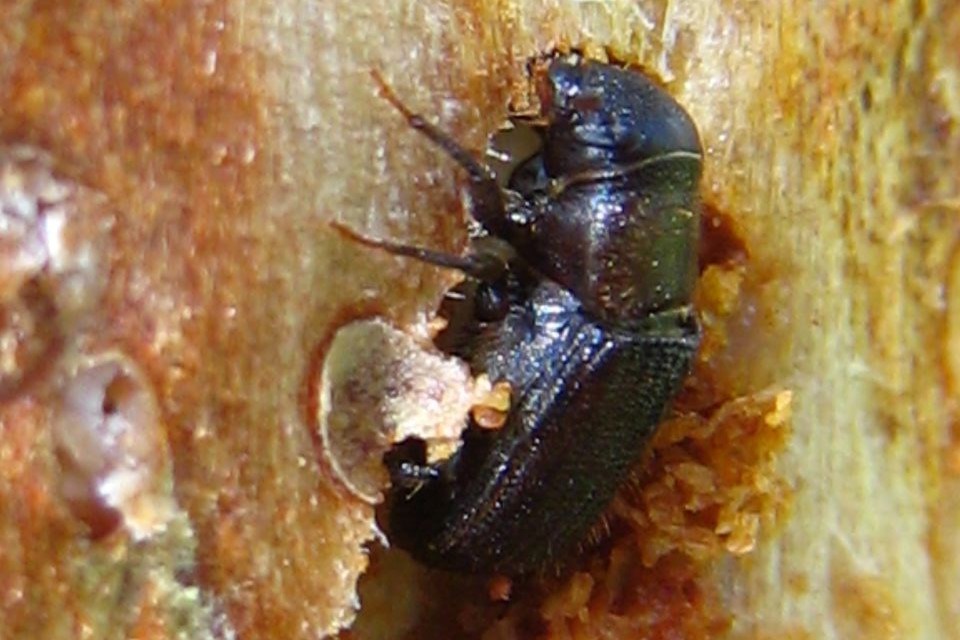As Jasper recovers from the wildfire that destroyed nearly a third of the town, some critics blame mountain pine beetle for turning the iconic national park into a tinderbox.
Antonia Musso, a postdoctoral fellow at the University of Alberta who has been working with mountain pine beetle in Alberta since 2016, is one of many experts who isn’t convinced the infestation played a role.
“I think it’s really unlikely that the kill from the pine beetle had an impact on the wildfire in Jasper,” Musso said.
While older scientific literature suggests that beetle-killed trees would increase the severity of wildfires, more recent literature indicates that it depends on how long it has been since the outbreak.
Musso said wildfire severity was at its worst between zero and three years post-outbreak when the trees are red. The peak of the outbreak in Jasper was between 2017 and 2019, five to seven years ago, before a major cold snap killed off most of the beetles.
When infested trees are in the grey attack phase, such as in Jasper, specifically when the trees are grey, have lost all their needles and are dried out, they likely have no impact on fire and may even dampen fires.
“It doesn’t really matter what kind of fuel is out there right now when you have such a hot, dry year,” Musso said.
The federal government has repeatedly denied that poor forest management contributed to the Jasper wildfire. Earlier this month, Prime Minister Justin Trudeau and Conservative Party Leader Pierre Poilievre got into a heated debate about Jasper wildfire preparedness.
Environment Minister Steven Guilbeault, who is the minister in charge of Parks Canada, testified before a federal committee last month that wildfire mitigation work had been ongoing in Jasper National Park for decades.
“The total area treated in Jasper National Park since 2014 is approximately 1,700 hectares,” Guilbeault said. “However, devastating the fire was, Parks Canada['s] response and preparedness ensured that it wasn’t much, much worse.”
Ken Hodges, a former registered professional forester in B.C. who had warned in 2018 about a potential “mega-fire” in Jasper, told the committee at a later date that not enough had been done to address the beetle-killed timber on the landscape.
“What was done was insignificant and poorly thought out,” Hodges said. “It did nothing to protect the town from the Jasper wildfire complex.”
An independent after-action review is expected to examine the Jasper wildfire at a future date. This happened for the Fort McMurray and Slave Lake fires.
Musso emphasized it was important to highlight the complexity of the issue.
“I think it’s really easy for folks to just blame it all on mountain pine beetle kill when what was the most important thing in the wildfire severity was actually weather conditions and climate and, of course, the drought period that Alberta is in right now,” she said.
Musso described mountain pine beetle as “an easy thing to pick on” because the killed trees were so visible to the public, whereas climate was less tangible.
Mountain pine beetle, nonetheless, remains a concern due to impacting the natural beauty of national parks such as Jasper and negatively affecting the timber industry elsewhere.
A silver lining to an otherwise devastating fire is many infected trees have been destroyed. Pine forests also require fire to regenerate since pine cones are sealed with resin and only open and release seeds under heat.
“In this case, in Jasper, the areas that have been burned have a higher probability of regenerating a similar forest to what it was before, whereas in more northern Alberta, like in the Peace region, when they’re looking at what’s regenerating, it’s not being replaced by similar forest,” Murro said.
She added mountain pine beetle was a natural disturbance agent and typically only attacks older trees unless it’s a hyperendemic outbreak similar to what happened in B.C. during the late ‘90s and early 2000s.
In terms of stopping the spread, Murro said forest management practices can make a difference. This includes planting a variety of species, thinning forests and planting trees at different times so they are different ages.




